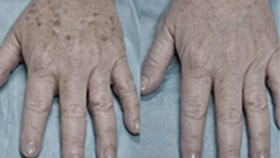PRP
Hair Restoration with Platelet-Rich Plasma for Marco Island, Bonita Springs, Ft. Myers, and Naples, FL
Tens of millions of people—both men and women—deal with androgenic alopecia, otherwise known as hereditary hair loss. As adults continue to age, many find that the follicles on their scalps begin to "shut down," leading to receding hairlines, widening parts, and bald spots. There are many proposed solutions for this common problem, but our team has found that an especially effective treatment is PRP. At the Naples-area Skin Wellness Physicians office, we use PRP (short for "platelet-rich plasma") to reinvigorate the follicles, leading to a fuller head of hair without the need for grafts.
Talk to Skin Wellness Physicians to find out more about the benefits of hair restoration with platelet-rich plasma (PRP) in Naples, FL, and Marco Island. Book a consultation by sending a message online or calling (239) 732-0044.
What is PRP?
Platelets are small cell fragments found in your blood, responsible for helping clots to form. Basically, they prevent excessive bleeding and heal wounds. If properly collected, processed, and applied, their healing properties can be used for more than closing cuts. Because platelets are such powerful pieces of cells, they can rejuvenate processes in the skin that slow with age, including collagen production and hair growth.
For a PRP session, a small amount of the patient's blood is taken, then spun in a centrifuge, which is a machine used to extract the platelets from the rest of the blood, such as the red and white blood cells. The platelets are then concentrated into the plasma—which is the liquid part of the blood—forming the PRP. This is injected, but into a new area. In this case, it's the scalp, where the highly concentrated platelets in the PRP revive the follicles and prompt new hair growth.
PRP also boosts the production of collagen and elastin, increases skin's hydration levels, and contains antioxidants. All of this improves the health of the scalp and hair.
What Type of Hair Loss Can PRP Address?
There are many reasons someone may notice that their hair is thinning or falling out. Possible causes of hair loss include stress, diet, chronic illness, certain medications, and trauma. In some cases, giving hair that fell out time to grow back is all that is needed. In others, a change in eating habits or exercise might be required. For patients who lose their hair due to medical treatments—such as chemotherapy—it is necessary to finish the course and then let hair re-grow naturally. It is important to allow a physician to examine your head in order to determine the underlying cause of your hair loss, so the best strategy can be implemented.
When the problem is hereditary, with genetics causing follicles to shrink and "give out" over time, it is possible to use PRP to kick-start production again.
Patients who have this condition, androgenic alopecia, tend to notice their hair thinning or falling out in an expected pattern: For men, the hairline moves back and up, and a bald patch may develop on the crown. These two balding areas can meet, creating a bare front and top of the scalp. Women tend to notice more generalized thinning, causing the lines where they part their hair to appear wider.
What Can You Expect After a PRP Session?
Most patients experience minor discomfort before and after this cosmetic procedure. Patients usually have some temporary redness, swelling, tingling, bruising, and pressure on the site where they are injected. There is no recovery time, and hypersensitivity or allergic reactions won't usually occur because the patient's own blood is used rather than a synthetic substance.
Follicles take time to "wake up" again, and then more time to begin producing new hairs. Expect to start to seeing results in the month or two after a PRP treatment session, with improved results developing over the following weeks.
For more details on hair restoration with platelet-rich plasma (PRP) in Naples, FL, and Marco Island, contact Skin Wellness Physicians today. Request a consultation by sending a message online or calling (239) 732-0044.

















